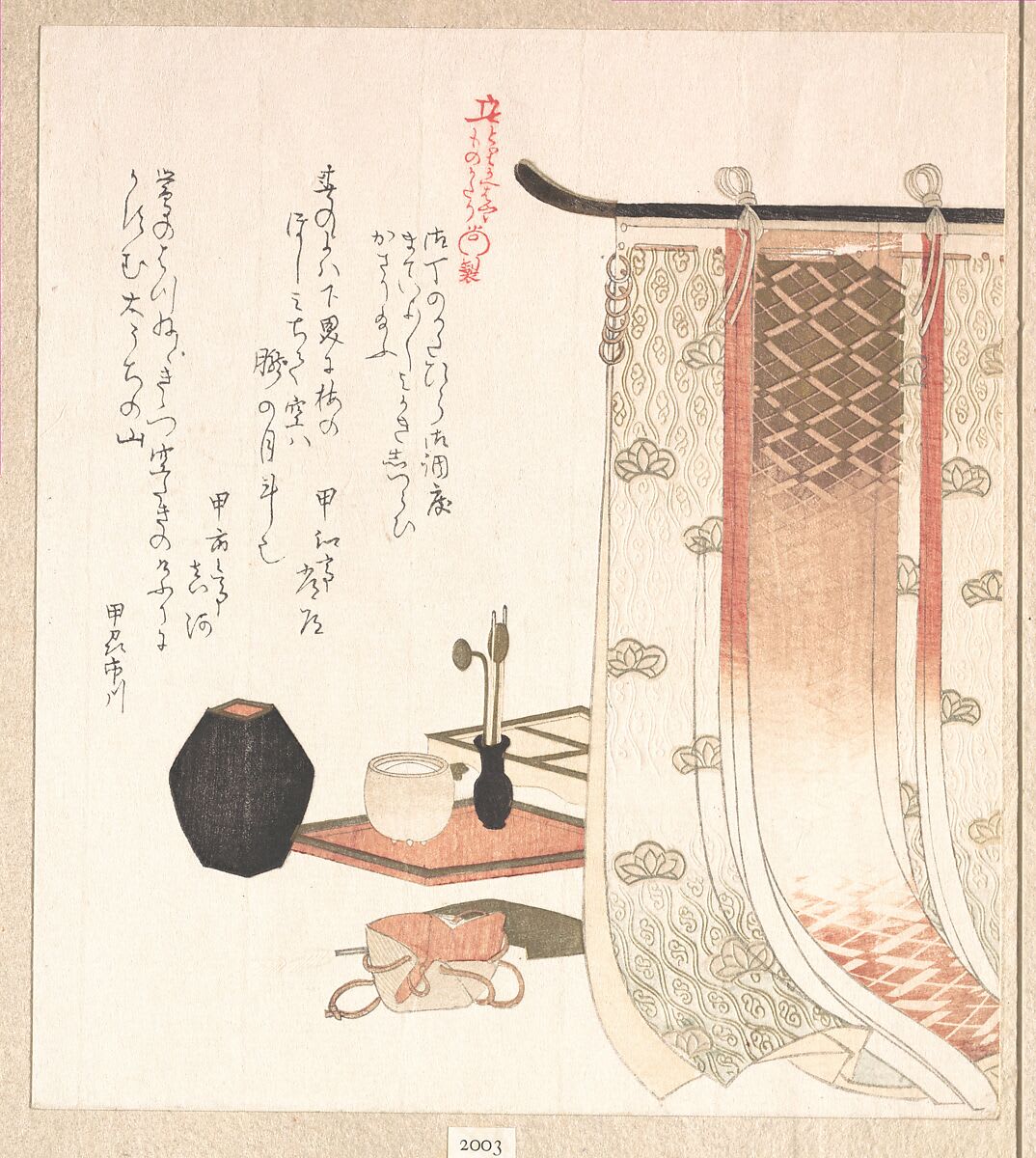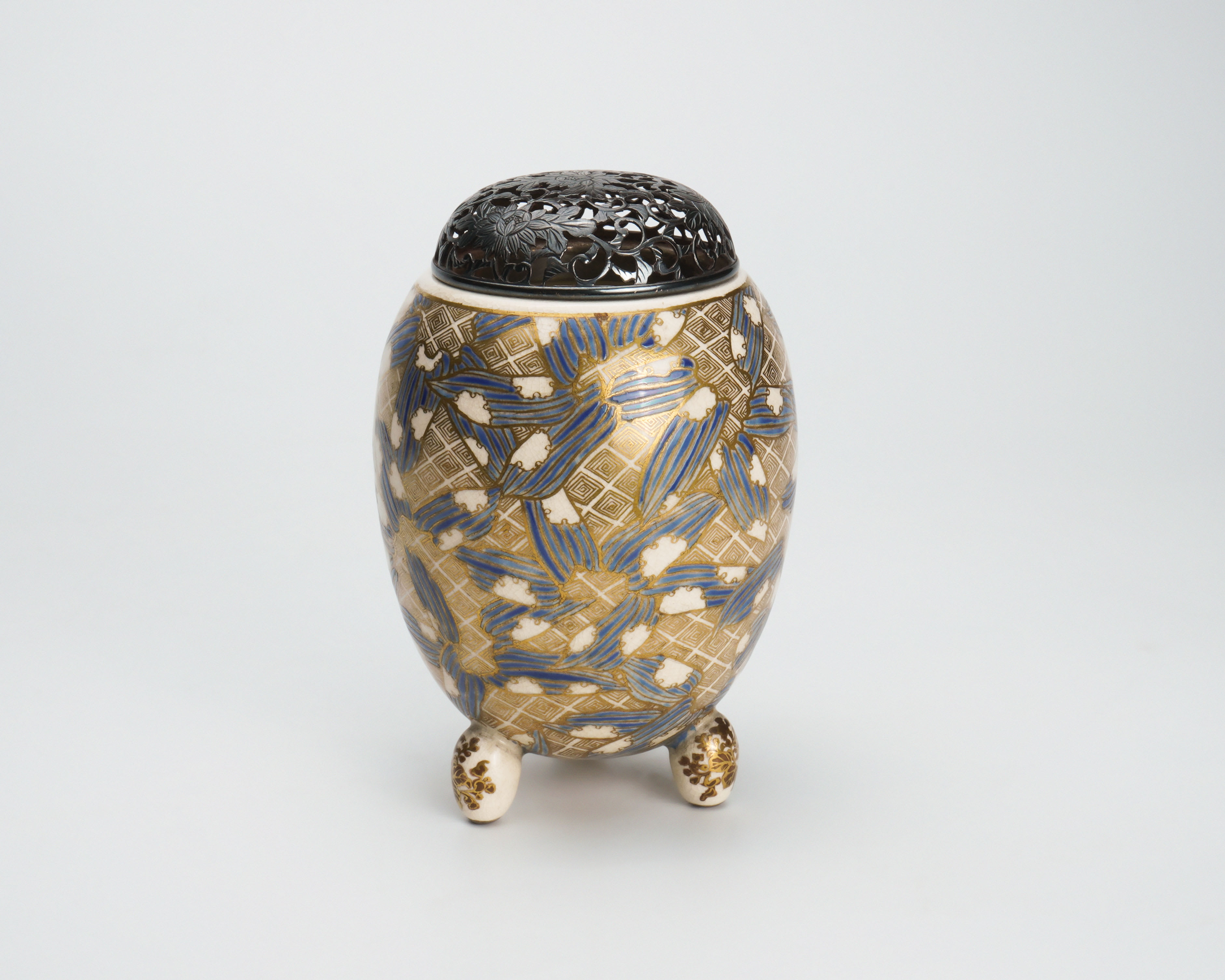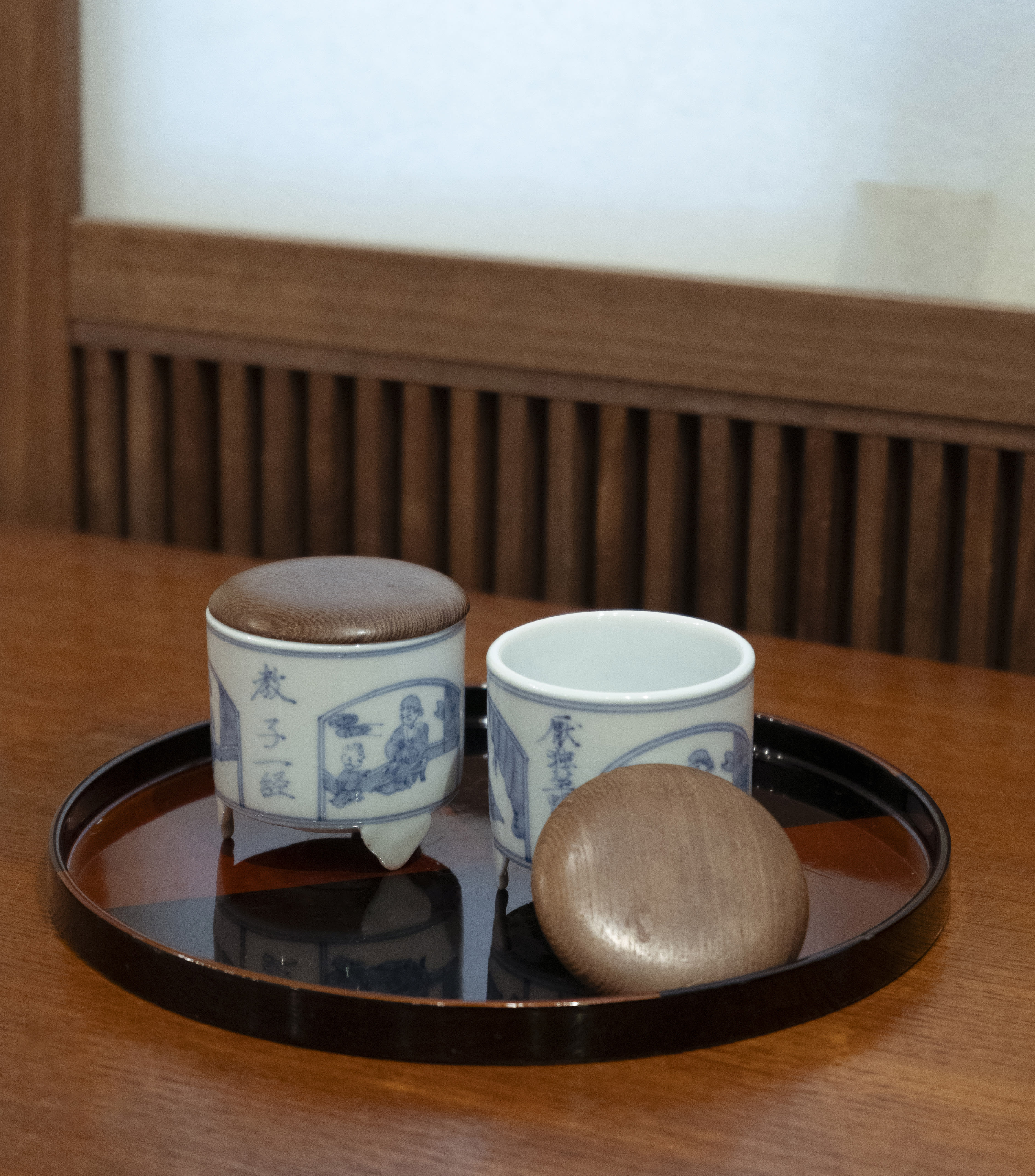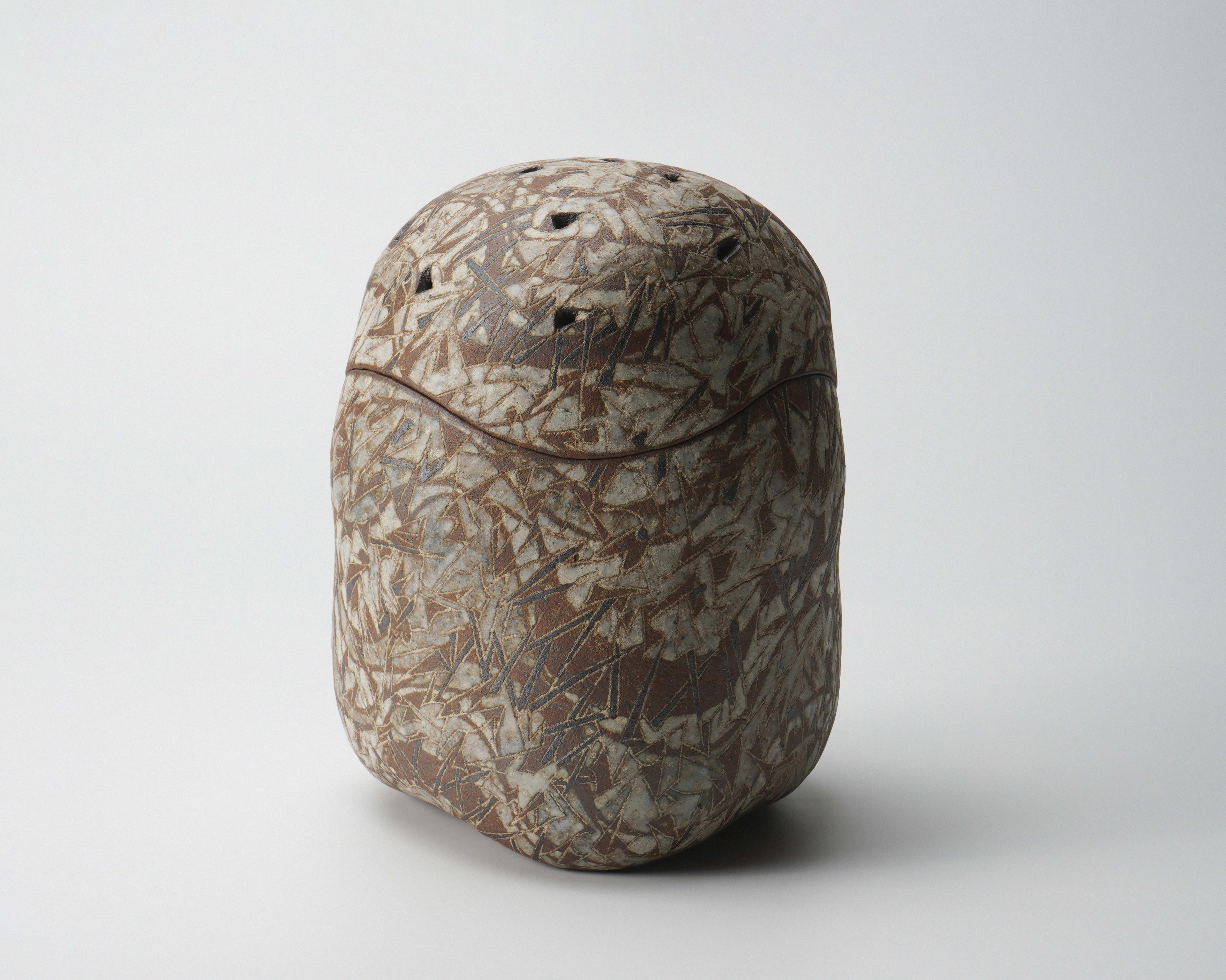
Kōdō 香道, often translated as “The way of fragrance,” is known as one of three classical Japanese arts of refinement for the Japanese tea ceremony (sadō) and the art of flower arrangement (kadō). Codified during the Muromachi period, Kōdō is both an aesthetic pursuit and a meditative discipline. Practitioners engage with incense through games such as Kumikō and Genjikō, which encourage comparative appreciation, and through the contemplative practice of Monkō, in which participants are invited to listen to incense rather than merely smell it. This approach reflects a broader Japanese sensibility that emphasizes attention, restraint, and the cultivation of awareness.
Kōdō also encompasses a rich world of implements and material culture that span ceramics, metalwork, woodcraft, and other mediums. Incense burners known as kōro, often fitted with ceramic or metal lids. Ceramic containers for storing incense (Kōgo), are also among the central objects associated with this practice. These forms, represented in this catalog, embody the relationship between fragrance and ritual through craft.

Kubo Shunman 窪 俊満 (1757–1820), Screen and Utensils for the Incense Ceremony Surimono, Edo period c. 19th century, woodblock print (surimono); ink and color on paper, 20.5 x 18.4 cm. O. Havemeyer Collection, Bequest of Mrs. H. O. Havemeyer, 1929. Permanent collections of the Metropolitan Museum of Art. Image courtesy of the museum.
The origins of incense culture in Japan trace back to the sixth century with the arrival of Buddhism. Agarwood was imported for the production of jinkō (沈香), and incense was used in the form of funkō (焚香), a method in which aromatics were placed atop burning charcoal. The act of burning fragrance was understood as a devotional offering intended to reach the Buddha. During the Muromachi period, an influx of rare fragrant woods and aromatics reached Japan as gifts to the imperial court. Their introduction into courtly life facilitated the expansion of incense use beyond religious contexts. Incense became interwoven with secular cultural practices and daily environments, giving rise to a sophisticated sensory culture.
Although fragrance is central to Kōdō, the tradition stresses the importance of “listening to incense.” This practice reflects the animistic nature of Japanese cultural thought, in which materials are understood to possess spirit. Craftspeople working with wood or stone often describe listening to their medium. Similar attention is cultivated in Kōdō as the participant refines the mind through careful engagement with scent. The act of listening becomes a meditative activity that sharpens perception and clarifies the senses.
Central to this experience are the “Ten Virtues of Incense,” or kōjuttokuto (香十徳) in Japanese. Attributed to the Northern Song poet Huang Tingjian 黄 庭堅 and transmitted to Japan by the monk Ikkyu Sōjun 一休 宗純, these virtues articulate the spiritual and physical benefits of incense:
- 感格鬼神 : Sharpens the senses
- 清浄心身 : Purifies the body and the spirit
- 能払汚穢 : Eliminates pollutants
- 能覚睡眠 : Awakens the spirit
- 静中成友 : Heals loneliness
- 塵裏愉閑 : Calms in turbulent times
- 多而不厭 : Is not unpleasant, even in abundance
- 募而知足 : Even in small amounts is sufficient
- 久蔵不朽 : Does not break down after a very long time
- 常用無障 : A common use is not harmful
These virtues underscore the holistic nature of Kōdō, showing its philosophical, and spiritual qualities. Object used in Kōdō are added to a ritual to emphasize the above values.
 Ninsei-style Incense Burner with Flowers of the Four Seasons,, Workshop of Nonomura Ninsei (active c. 1646–94) , Edo period (1615–1868), c. 17th Century, Japan , stoneware with polychrome overglaze enamels and gold; openwork gilt-bronze cover, (h) 17.1 (w) 8.4 (d) 18.4 cm. H. O. Havemeyer Collection, Bequest of Mrs. H. O. Havemeyer, 1929. Permanent collections of the Metropolitan Museum of Art. Image courtesy of the museum.
Ninsei-style Incense Burner with Flowers of the Four Seasons,, Workshop of Nonomura Ninsei (active c. 1646–94) , Edo period (1615–1868), c. 17th Century, Japan , stoneware with polychrome overglaze enamels and gold; openwork gilt-bronze cover, (h) 17.1 (w) 8.4 (d) 18.4 cm. H. O. Havemeyer Collection, Bequest of Mrs. H. O. Havemeyer, 1929. Permanent collections of the Metropolitan Museum of Art. Image courtesy of the museum.
 Ito Tozan Ⅰ 初代 伊東陶山 (1846-1920), Incense burner with bamboo leaves over golden geometric diamond motifs, with signed wood box, porcelain, H12.06 x W8.25cm. Learn more about this item here.
Ito Tozan Ⅰ 初代 伊東陶山 (1846-1920), Incense burner with bamboo leaves over golden geometric diamond motifs, with signed wood box, porcelain, H12.06 x W8.25cm. Learn more about this item here.
Formally speaking, Incense burners, or kōro, have evolved significantly throughout Japanese history. The ceramic forms we know today have a long lineage of variety. Early burners were created for religious settings and often resembled Chinese bronze models with large openings. These types of burners, archaic, and large, played with scale as a significant aspect of its object-hood, and were imported into Japan along with monks from China and Korea.
As incense appreciation migrated into domestic and courtly environments during the 17th century in Japan, practices like Monkō and Kumikō (two types of incense games designed to experience the sensory pleasures of incense, and enhance awareness of the fragrance offered) gained popularity among the literati class. As they grew more popular, accompanying incense implements grew smaller and more intimate. These compact burners were designed to suit refined spaces and the personal contemplation that Kōdō requires, thus evolving into the ceramic forms that we associate with Kōdō today.

Black Raku incense burner in "melon" shape, Imitation of Ogata Kenzan 尾形 乾山 (1663-1743) Kyoto workshop, 19th century, Kyoto, Japan, Earthenware, (h) 9.7 x (w) 9.7 cm., Charles Lang Freer (1854-1919), purchased from Kita Toranosuke in Kyoto in 1907. Permanent collections of the Smithsonian Museum, Freer Gallery of Art Collection, National Museum of Asian Art, Smithsonian. Image courtesy of the museum.
 Kamada Koji 鎌田 幸二 (b. 1948), Incense burner, withsigned wood box, stoneware, H9.5 × W9 cm. Click here to learn more about this item.
Kamada Koji 鎌田 幸二 (b. 1948), Incense burner, withsigned wood box, stoneware, H9.5 × W9 cm. Click here to learn more about this item.
Kōdō developed alongside the tea ceremony during the Muromachi period as both practices were shaped by the broader philosophy of geidō, the way of art. Geidō emphasized personal cultivation through disciplined aesthetic training. Tea masters often began a tea gathering by burning incense, an act believed to purify the participants and prepare their spirits for the contemplative experience that followed.
The intersection of fragrance and tea extends deeply into Japanese aesthetics: Both practices emphasize multi-sensory awareness, spatial refinement, and an understanding of subtlety of objects’ forms. Incense sets the atmosphere before tea is served, guiding participants toward mindfulness. Unlike Western perfumery, Japanese incense focuses on the inherent character and quality of a single natural material.
 Ito Tozan III 三代 伊東 陶山 (1900-1970), white porcelain incense burner, withsigned wood box, porcelain, H10.5 × W8.7 cm. Learn more about this item here.
Ito Tozan III 三代 伊東 陶山 (1900-1970), white porcelain incense burner, withsigned wood box, porcelain, H10.5 × W8.7 cm. Learn more about this item here.
 Two floating tripod sometsuke Kikikoro made of porcelain for Kumikō incense games. Made by the Showa era incense master from Aichi, Hachiya Soyu (1902-1988), who was the 19th head of the Shino-ryu (Shino school of Incense). Learn more about the objects here.
Two floating tripod sometsuke Kikikoro made of porcelain for Kumikō incense games. Made by the Showa era incense master from Aichi, Hachiya Soyu (1902-1988), who was the 19th head of the Shino-ryu (Shino school of Incense). Learn more about the objects here.
Fragrance games such as kumikō are incorporated into tea ceremony practice to cultivate the guest’s ability to “listen to the fragrance.” These games use specialized containers called kikikōro (聞香炉) with high walls designed to hold and present the incense, as exemplified by the pair of floating tripod sometsuke kikikōro by Hachiya Sōyu 蜂谷 宗由 above. By “listening to the fragrance,” practitioners shift their consciousness into a realm shaped by the aromatics being presented. This process prepares the mind to enter the environment of the tea room.
The Meiji Restoration (c. 1868-1889) brought rapid Westernization and a decline in traditional fragrance practices. Although incense had long been part of aristocratic life since the Heian period, and was also used by samurai to purify the spirit before battle, these customs were discouraged as Japan adopted Western cultural forms. By the late nineteenth century the utilitarian view of Kōdō had diminished significantly.
 Wada Morihiro 和太 守卑良 (1944-2008), Incense burner, Ryu-san-mon, with signed wood box, stoneware, H17.8 × W14 × D13.8 cm. Private collection. A comparable example of this incense burner is found at the National Museum of Crafts, Japan: click here to see images.
Wada Morihiro 和太 守卑良 (1944-2008), Incense burner, Ryu-san-mon, with signed wood box, stoneware, H17.8 × W14 × D13.8 cm. Private collection. A comparable example of this incense burner is found at the National Museum of Crafts, Japan: click here to see images.
In 1890, traditional arts regained acceptance and Kōdō experienced a revival. By this time, however, the visual language of incense implements had begun to shift. Censers and related tools increasingly reflected Western tastes as makers and manufacturers adapted their work for a growing global market. During this shift, the functional use of incense implements gradually expanded into that of decorative objets d’art. Many ceramicists took this opportunity to explore new formal expressions in incense containers, incorporating more individualistic and expressive elements into their craft. The treatment and perceptions of the ceramic incense object changed during these changing cultural economies. This radical shift is exemplified by contemporary ceramic artists such as Wada Morihiro, Nagae Shigekazu, and several others that followed in the footsteps of individualistic artistic expression through the ceramic medium.
Article by Naomi Saito and Kristie Lui. This article was published on the occasion of "Ritual and Renewal: Modern Japanese tea caddies and incense implements," exhibited at Dai Ichi Arts in November 2025. Learn more about the exhibition here.